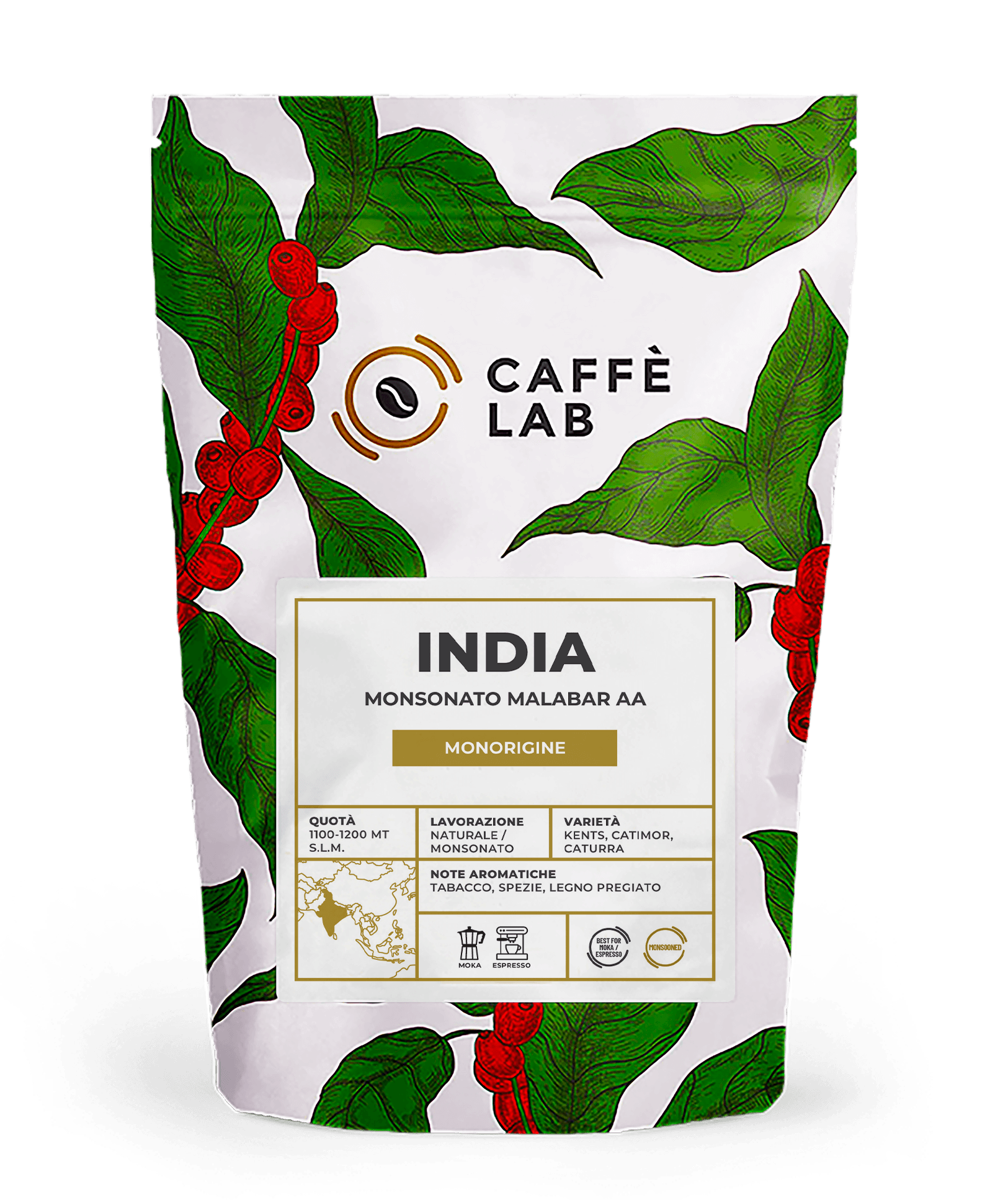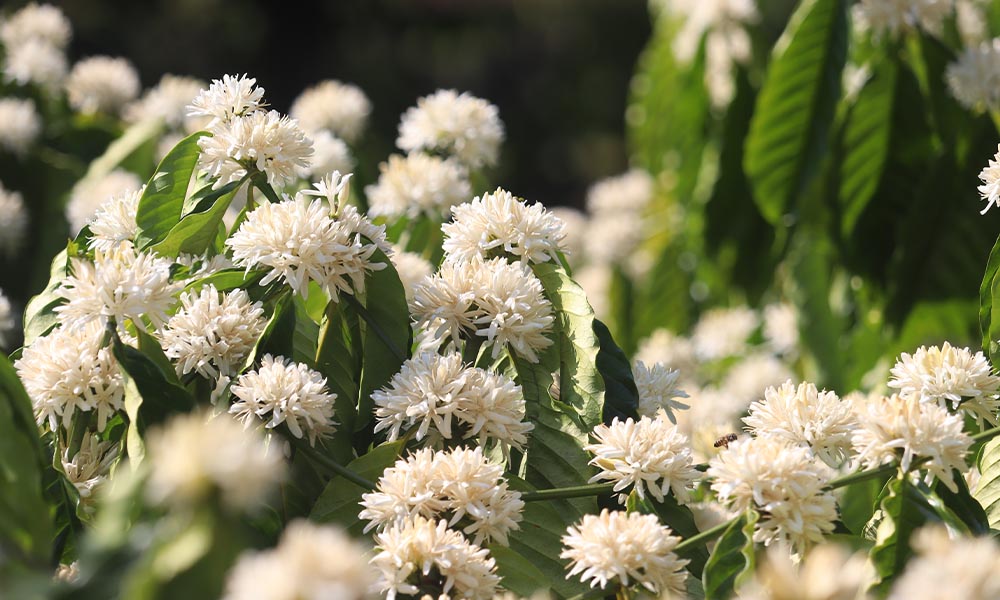
India
Monsooned Malabar AA


If today we can enjoy the best coffee in the cup, the credit comes precisely from the coffee plant. When we think of coffee, our mind immediately goes to the beverage, to its enveloping aroma and to the golden crema of the espresso. And yet, everything begins much earlier, in the green heart of a tropical plant that for centuries has fascinated farmers, botanists and enthusiasts all over the world. Knowing coffee plantations is essential to truly understand the differences between one blend and another, between an acidic and floral Arabica and a Robusta with an intense body.
In this journey, we will guide you through the discovery of the plant from which everything originates: from its morphological characteristics to the cultivated varieties, from the ideal climates to the flowering and ripening phases, up to exploring how terroir influences the final aromatic profile of the coffee.
The coffee plant is a shrub belonging to the Coffea genus, which includes over 100 different species, although only two are widely used for commercial production: Coffea arabica and Coffea canephora (known as robusta). Arabica and robusta are not simple varieties, but distinct botanical species with precise agronomic, chemical and taste characteristics.
Coffea arabica is a more delicate plant, sensitive to pests and diseases, requiring cool climates and high altitudes. It produces elongated, flat beans with lower caffeine content and superior aromatic finesse. Its profiles can range from chocolate to jasmine, from citrusy notes to caramel.
Coffea canephora, or robusta, on the other hand, is more resistant, growing well even at low altitudes and in hotter and more humid climates. Its beans are rounder, with a higher caffeine concentration, which makes it more bitter, full-bodied and intense. It is often used to enhance the crema of espresso and to give structure to coffee blends.
There are also two other lesser-known types: Coffea Liberica originates from Liberia and some areas of Ivory Coast and Ghana. It is a resistant, adaptable and vigorous species, capable of growing even in difficult environmental conditions, with poor soils and hot, humid climates. It stands out for its imposing size: it can reach up to 10 meters in height, with very large leaves and bigger fruits compared to Arabica and Robusta.
Coffea Excelsa, now classified as a variety of Coffea Liberica, is one of the rarest and most fascinating types in the world of coffee. Native to Central Africa, this plant is notable for its remarkable climatic resistance and its ability to grow even in poor soils, making it valuable in challenging agricultural contexts. In the cup, Excelsa offers a unique and complex aromatic profile, with notes of ripe fruit, citrus, tamarind and spices, accompanied by pleasant acidity and a light structure. Often used to enrich specialty coffee blends, Coffea Excelsa represents a precious resource for those seeking new and surprising sensory experiences, while also enhancing the biodiversity and resilience of coffee cultivation. Coffea Excelsa is now recognized as Coffea dewevrei (formerly classified as Coffea liberica var. dewevrei), one of the rarest and most fascinating varieties in the coffee world. Native to Central Africa — particularly regions such as Uganda, the Democratic Republic of Congo and Chad — this plant is distinguished by its strong climatic resilience and its ability to adapt to poor soils and high temperatures, qualities that make it valuable in difficult agricultural environments or those threatened by climate change.

In the cup, Excelsa offers a complex and surprising aromatic profile, characterized by notes of ripe fruit, citrus, tamarind and light spicy nuances, with a medium body and lively yet balanced acidity.
Although representing less than 1% of global coffee production, this variety has begun to attract the interest of roasters and researchers in the specialty coffee sector, who consider it a promising resource to diversify plantations and enrich high-quality blends with new and unexpected aromas.
Coffea Excelsa is not just a botanical curiosity: it is a symbol of coffee biodiversity and resilience, capable of combining the rarity of a nearly forgotten species with the sensory potential of a coffee waiting to be rediscovered.
The coffee plant is evergreen, with glossy oval leaves of deep green, which can reach up to 15 cm in length. The best coffee blends in the world are the result of these extraordinary plants.
The coffee flowers, small and white, bloom in fragrant clusters reminiscent of jasmine in their intensity. Flowering generally occurs after the rainy season and may last only a few days. From these flowers will grow the drupes, the coffee fruits, which ripen slowly, changing from green to deep red or yellow, depending on the variety. Inside them are two seeds, the future coffee beans which, after being harvested, processed and roasted, become the base of our favorite beverage. The basis for an organic coffee starts precisely from cultivation without the use of chemical fertilizers, additives or pesticides. Moreover, a single-origin coffee comes from plants grown only in a specific country, farm or even a single plot within a cooperative of small producers. They are truly unique because they are not blended with coffees of other varieties or origins.
The coffee plant grows exclusively in a tropical belt between the Tropic of Cancer and the Tropic of Capricorn, also called the “coffee belt.” The major producing countries are located in Latin America, Africa, India and Southeast Asia. Ideal conditions for cultivating Arabica include stable temperatures between 18 and 24°C, altitudes between 600 and 2000 meters, good rainfall and well-drained soils.
Altitude plays a fundamental role in the sensory quality of coffee. Plants grown at higher altitudes, especially Arabica, develop their fruits more slowly, allowing for greater concentration of sugars and aromatic compounds. This results in a cup with greater complexity, bright acidity and floral or fruity notes.

The coffee plant takes about 3–4 years after planting to begin production. Cherry ripening can take from 6 to 11 months, depending on climate and variety. In some tropical regions, flowering occurs only once a year; in others it may be staggered, with multiple harvests.
Harvesting can be manual or mechanical. Selective picking, meaning hand-harvesting only the ripe fruits, is the most expensive but also the most effective method for obtaining superior-quality coffee. Unripe or overripe beans compromise aromatic balance, producing unpleasant notes.
After harvesting, the fruits undergo different processing methods (washed, natural, honey), which further influence flavor profile. This is when the botanical raw material meets human intervention and artisanal expertise—elements that CaffèLab enhances in every selected lot.
To understand the coffee plant is to come closer to a fascinating universe made of biodiversity, agricultural work, environmental respect and enhancement of terroir. Every plant carries the identity of the place where it grows, the hands that cared for it, the agronomic choices that shaped its evolution.
From Brazil to Ethiopia, from Colombia to Vietnam, each plantation is a unique microcosm. And each botanical variety, every hybrid selected to resist diseases or improve yield, represents a tile in the enormous mosaic of today’s coffee cultivation.
To truly appreciate what we drink every day, we must start here: from the plant. It is thanks to it that we can explore a vast sensory range made of citrusy acidity, round body, floral or spicy notes.
On CaffèLab you will find not only coffee beans from selected plantations, but also in-depth content, technical sheets and tasting guides that help you connect what’s in your cup to what grows in the fields. Because a good coffee, even before being prepared, must be understood.